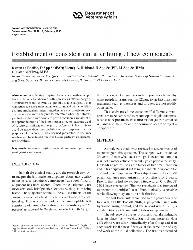Please use this identifier to cite or link to this item:
http://hdl.handle.net/11054/178Full metadata record
| DC Field | Value | Language |
|---|---|---|
| dc.contributor.author | English, Rowan D. | * |
| dc.contributor.author | Hubbard, Wendy A. | * |
| dc.contributor.author | McElroy, G. K. | * |
| dc.date.accessioned | 2013-01-15T00:08:40Z | en |
| dc.date.available | 2013-01-15T00:08:40Z | en |
| dc.date.issued | 1995 | en |
| dc.identifier.govdoc | 00162 | en |
| dc.identifier.issn | 0748-7711 | en |
| dc.identifier.uri | http://hdl.handle.net/11054/178 | en |
| dc.description.abstract | Since the time required for a person with an amputation to become familiarized with a prosthesis after a change of a component is not known, the gait of a single subject, a man with a through-knee amputation, was examined with two different knee mechanisms interchanged in the same prosthesis. Several parameters were analyzed to determine when the subject's gait had stabilized sufficiently to permit confident assessment of the appropriateness of the knee mechanisms. At least one week of functional walking was required before a clinical decision could be made about the suitability of the component. For the purposes of research, it was deemed preferable to try knee mechanisms for at least 3 weeks to be sure pertinent gait parameters stabilized. | en |
| dc.description.provenance | Approved for entry into archive by Gemma Siemensma (gemmas@bhs.org.au) on 2013-01-15T00:08:40Z (GMT) No. of bitstreams: 1JRRD.pdf: 423562 bytes, checksum: d4f2ea651e98f50dbd483df7f98e1f44 (MD5) | en |
| dc.description.provenance | Submitted by Gemma Siemensma (gemmas@bhs.org.au) on 2013-01-15T00:08:26ZNo. of bitstreams: 1JRRD.pdf: 423562 bytes, checksum: d4f2ea651e98f50dbd483df7f98e1f44 (MD5) | en |
| dc.description.provenance | Made available in DSpace on 2013-01-15T00:08:40Z (GMT). No. of bitstreams: 1JRRD.pdf: 423562 bytes, checksum: d4f2ea651e98f50dbd483df7f98e1f44 (MD5) Previous issue date: 1995 | en |
| dc.publisher | Department of Veterans Affairs | en |
| dc.title | Establishment of consistent gait after fitting of new components. | en |
| dc.type | Journal Article | en |
| dc.type.specified | Article | en |
| dc.bibliographicCitation.title | Journal of Rehabilitation Research and Development | en |
| dc.bibliographicCitation.volume | 32 | en |
| dc.bibliographicCitation.issue | 1 | en |
| dc.bibliographicCitation.stpage | 32 | en |
| dc.bibliographicCitation.endpage | 35 | en |
| dc.publisher.place | Baltimore | en |
| dc.subject.healththesaurus | GAIT | en |
| dc.subject.healththesaurus | AMPUTEES | en |
| dc.subject.healththesaurus | AMPUTATION | en |
| dc.subject.healththesaurus | PROSTHESIS | en |
| dc.subject.healththesaurus | ARTIFICAL LIMB | en |
| dc.subject.healththesaurus | BIOMECHANICS | en |
| dc.subject.healththesaurus | KNEE JOINT | en |
| dc.date.issuedbrowse | 1995-01-01 | en |
| Appears in Collections: | Research Output | |
Files in This Item:
| File | Description | Size | Format | |
|---|---|---|---|---|
| JRRD.pdf | Reproduced with permission from JRRD | 413.63 kB | Adobe PDF |  View/Open |
Items in DSpace are protected by copyright, with all rights reserved, unless otherwise indicated.
